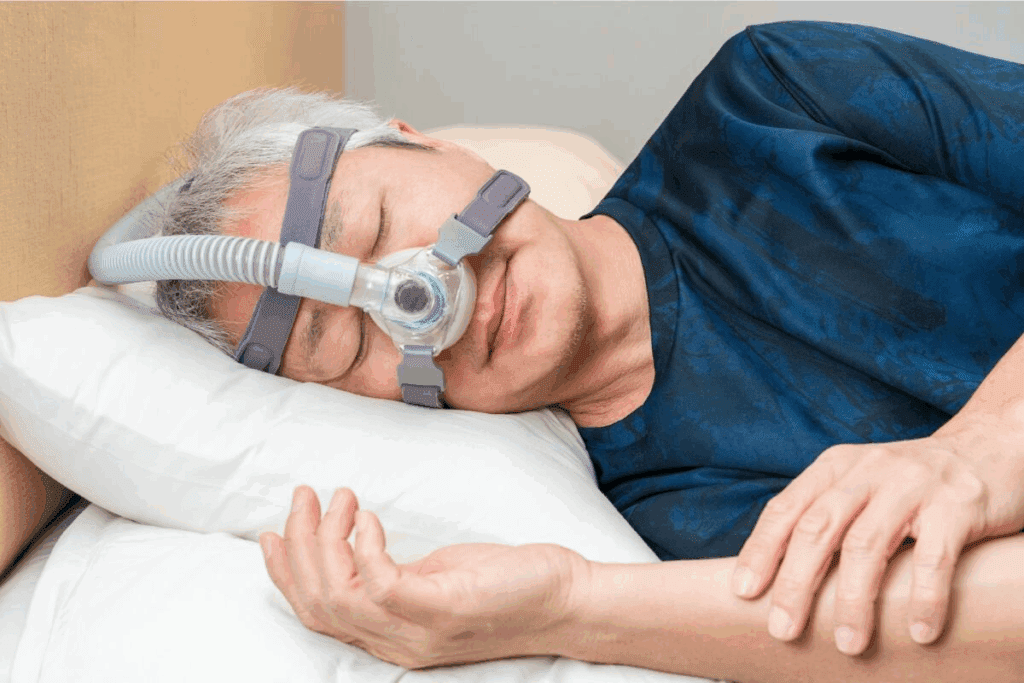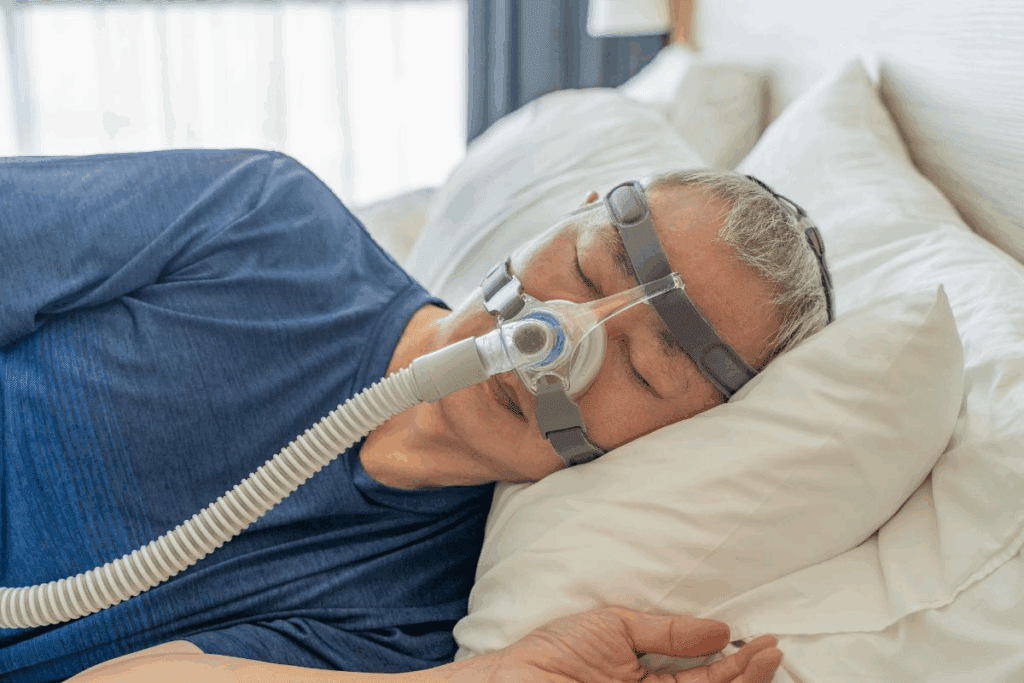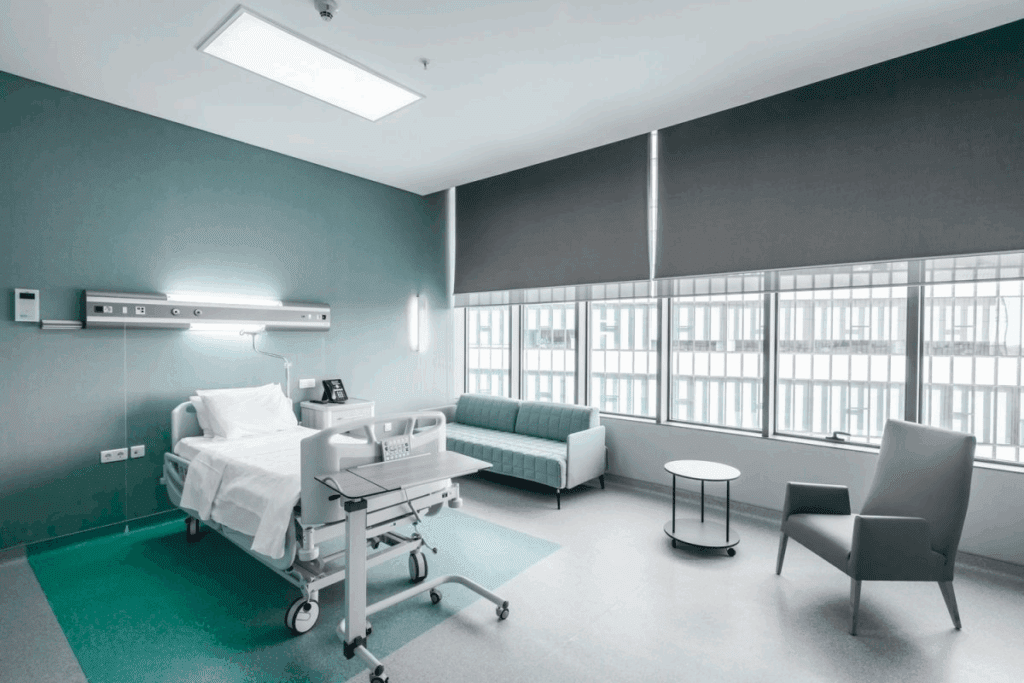Last Updated on November 20, 2025 by Hozen

Do you wake up feeling tired, even after a full night’s sleep? Your Apnea-Hypopnea Index (AHI) score might explain why. At Liv Hospital, we use this score to find out if you have sleep disorders.
AHI shows how many times you stop breathing or breathe less deeply per hour of sleep. Knowing your AHI score helps you understand your diagnosis and treatment options. Our team offers a patient-focused approach. We use the latest technology to create treatment plans that help you sleep better.

Diagnosing sleep apnea starts with the Apnea–Hypopnea Index. This index is key for doctors to see how bad obstructive sleep apnea (OSA) is.
AHI counts how many times breathing stops or slows down per hour of sleep. It shows how often sleep is disrupted by breathing problems.
This helps doctors understand how sleep apnea affects a person’s health. It shows how often and how bad these breathing stops are.
AHI is critical for finding out if someone has sleep apnea. It helps doctors decide the best treatment. This depends on how often and how bad the breathing stops are.
| AHI Score Range | Sleep Apnea Severity |
| Under 5 | Normal |
| 5-14 | Mild |
| 15-29 | Moderate |
| 30 or more | Severe |
Knowing about AHI is key for both patients and doctors. It helps in managing and treating sleep apnea.

To understand sleep apnea, it’s key to know about breathing events during sleep. These events help figure out how severe sleep apnea is. They are used to calculate the Apnea-Hypopnea Index (AHI).
Apnea events happen when there’s a full stop in airflow for at least 10 seconds. This pause can happen many times at night, making sleep poor. Apnea events are a key part in diagnosing sleep apnea, as how often they happen affects the AHI score.
Hypopnea events are when airflow drops by 30% or more for at least 10 seconds. Unlike apnea, hypopnea doesn’t mean breathing stops completely but drops a lot. These events also add to the AHI score and help figure out how bad sleep apnea is.
| Event Type | Description | Duration |
| Apnea | Complete stoppage of airflow | At least 10 seconds |
| Hypopnea | Reduction in airflow by 30% or more | At least 10 seconds |
Knowing about apnea and hypopnea events is key to understanding AHI scores and diagnosing sleep apnea. How often these events happen in an hour of sleep shows how severe the condition is.
Measuring AHI is key in sleep studies. It shows how severe sleep apnea is. AHI, or Apnea-Hypopnea Index, is measured in labs or at home.
Polysomnography (PSG) is an overnight sleep study. It records many body functions while you sleep. These include brain activity, eye movements, and breathing patterns.
Key components of PSG include:
The data from PSG helps calculate the AHI score. This score shows the number of sleep disruptions per hour.
PSG is usually done in a lab, but home sleep testing (HST) is also an option. HST uses a portable device to monitor a few key parameters.
| Testing Method | Parameters Monitored | Advantages | Disadvantages |
| Polysomnography (Lab Testing) | Brain activity, eye movements, muscle activity, heart rate, breathing patterns | Comprehensive data collection, accurate AHI measurement | Costly, requires overnight stay in a lab |
| Home Sleep Testing (HST) | Oxygen saturation, airflow, respiratory effort | Convenient, less costly, conducted in the comfort of home | Limited data compared to PSG, may not accurately diagnose complex cases |
Both methods are used to diagnose sleep apnea. The choice depends on the patient’s condition and insurance.
Knowing how AHI is measured helps patients understand their diagnosis. Whether in a lab or at home, the goal is to get an accurate score for treatment.
Understanding your AHI score is vital for managing sleep apnea. Your AHI score chart shows your sleep health. It tells you how severe your sleep apnea is by counting apneic events per hour.
An AHI score under 5 is normal. It means your sleep is mostly uninterrupted. Living a healthy lifestyle and regular sleep can help keep your AHI score low.
If your AHI score is 5 to 14, you have mild sleep apnea. It might not affect your daily life much. But, it’s important to watch your condition and think about making lifestyle changes or getting treatment.
An AHI score of 15 to 29 means you have moderate sleep apnea. Sleep disruptions are more common, which can impact your life. Talking to a healthcare professional about treatments like CPAP therapy or oral appliances is a good idea.
Having an AHI score of 30 or more means you have severe sleep apnea. This can lead to serious health problems if not treated. Working closely with your healthcare provider to find a treatment plan is essential.
Knowing your AHI score is the first step to managing sleep apnea. By understanding your score, you can make better health choices.
Knowing your Apnea-Hypopnea Index (AHI) score is key to managing sleep apnea well. The AHI score counts how many times you stop breathing or breathe shallowly per hour of sleep. It helps figure out how severe your sleep apnea is.
An AHI score of 1-5 is normal. This means you stop breathing or breathe shallowly less than 5 times per hour. It shows your sleep is mostly uninterrupted. Most people with this score don’t have serious sleep apnea.
AHI scores of 5-10 are borderline. People in this range might be at risk of sleep apnea or have mild apnea. It’s important to watch closely and possibly get more tests to figure out what to do next.
An AHI score under 5 is normal. But, what’s normal can change based on your health and other sleep issues. Always talk to a doctor to understand your situation better.
| AHI Score Range | Classification | Implications |
| 1-5 | Normal | Minimal sleep disruption |
| 5-10 | Borderline/Mild Sleep Apnea | Potential risk, monitoring recommended |
| 10-15 | Mild Sleep Apnea | Some disruption, treatment may be necessary |
| 15-30 | Moderate Sleep Apnea | Significant disruption, treatment likely necessary |
| 30+ | Severe Sleep Apnea | Major disruption, treatment necessary |
Getting to know your AHI score is just the start of managing sleep apnea. By teaming up with your doctor, you can create a treatment plan that fits you.
Sleep events per hour, as measured by AHI, are key in figuring out how bad sleep apnea is. The Apnea-Hypopnea Index (AHI) helps doctors see how often sleep is disrupted by obstructive sleep apnea (OSA).
“The AHI score gives a full view of a patient’s sleep apnea, helping doctors make treatment plans that fit,” says Dr. John Smith, a top sleep specialist. This tailored approach is key to managing sleep apnea well and helping patients get better.
Different AHI levels mean different health issues, from mild to severe sleep apnea. Knowing these effects is key to making good treatment plans.
Doctors use AHI scores to decide on treatments and check how well they’re working. By looking at AHI data, they can find the best treatment for each patient.
For example, someone with a high AHI score might need CPAP therapy, while someone with a lower score might just need to change their lifestyle. Keeping an eye on AHI scores helps doctors adjust treatments as needed, making sure sleep apnea is managed well.
In short, knowing the importance of sleep events per hour is vital for managing sleep apnea. By understanding the health effects of different AHI levels and using AHI scores to guide treatment, doctors can give care that really helps patients.
Sleeping position greatly affects sleep apnea. The supine AHI index measures apneic and hypopneic events per hour when sleeping on the back. It’s key for understanding position-dependent sleep apnea, where sleep apnea gets worse or better based on how you sleep.
Our sleep position can make sleep apnea better or worse. Sleeping on your back can make it worse because your tongue and soft palate can block your airway. This leads to more apneic and hypopneic events. Sleeping on your side might help reduce sleep apnea severity.
Knowing how sleep position affects you is vital for treatment. For example, those with position-dependent sleep apnea might find relief with positional therapy. This involves using devices or techniques to help you sleep on your side.
Looking at both supine and non-supine AHI scores gives us important insights. A big difference between these scores means you have position-dependent sleep apnea.
| Sleeping Position | AHI Score Interpretation |
| Supine | Higher AHI scores mean more severe sleep apnea when sleeping on your back. |
| Non-Supine | Lower AHI scores suggest less severe sleep apnea when sleeping on your side or stomach. |
| Difference between Supine and Non-Supine AHI | A big difference means you have position-dependent sleep apnea. |
Healthcare providers can use these metrics to create better treatment plans. This can help those with position-dependent sleep apnea a lot.
REM and non-REM sleep stages affect AHI differently. This is key for managing sleep apnea well. Knowing these differences helps in diagnosing and treating sleep apnea effectively.
Sleep is split into REM and non-REM stages. Each stage affects breathing in unique ways. REM sleep is when dreams are vivid and brain activity is high.
Non-REM sleep, on the other hand, is deeper and helps us rest. It has slower brain waves.
Breathing events like apneas and hypopneas change between REM and non-REM sleep. In REM sleep, muscle relaxation can make breathing harder. This increases the chance of sleep apnea.
Key differences in AHI between REM and non-REM sleep include:
REM-related AHI is important for diagnosis and treatment. Patients with more sleep apnea in REM sleep may have different symptoms. This affects how severe their sleep apnea is.
“The distinction between REM and non-REM AHI can provide valuable insights into the pathophysiology of sleep apnea and guide personalized treatment strategies.” – Dr. John Smith, Sleep Specialist
Knowing the difference between REM and non-REM AHI helps doctors:
| Sleep Stage | Characteristics | Impact on AHI |
| REM Sleep | Increased brain activity, muscle relaxation | Higher frequency of apneic events |
| Non-REM Sleep | Slower brain waves, restorative sleep | Variable AHI, often lower than REM |
By looking at both REM and non-REM AHI, doctors get a better picture of sleep apnea. This leads to better management and outcomes for patients.
Diagnosing sleep apnea in kids relies on the Apnea-Hypopnea Index (PAHI). This metric is different for children than adults. It’s important to use age-specific criteria for accurate diagnosis and treatment.
The PAHI score is used to measure sleep apnea in kids. Unlike adults, where a score of 5 or more is abnormal, kids have different standards. A score above 1 is unusual in children, showing possible sleep apnea. This is because kids’ airways are smaller and more likely to block.
Several factors make the diagnostic criteria for kids different from adults:
Understanding PAHI scores in kids needs a detailed look at their situation. A score above 1 event per hour is seen as abnormal and needs more study. The PAHI score shows how severe sleep apnea is in kids, with higher scores meaning more severe apnea.
When looking at PAHI scores, doctors must think about:
Getting the PAHI score right is key for treating sleep apnea in kids. By knowing the special needs of pediatric sleep apnea, doctors can give better care. This helps improve the lives of these young patients.
To really understand sleep apnea, we need to look at more than just AHI. Metrics like ODI, RDI, and Sleep Fragmentation give us deeper insights. They show how severe sleep apnea is and its effects on health.
The Oxygen Desaturation Index (ODI) counts how often oxygen levels drop during sleep. This usually happens when someone has apneic or hypopneic events. It’s key because it shows how these events affect blood oxygen.
ODI Significance: A high ODI means oxygen levels drop more often. This can harm the heart and lead to other health issues.
| ODI Range | Severity | Clinical Implication |
| <5 events/hour | Normal | No significant desaturation |
| 5-14 events/hour | Mild | Some desaturation events; monitor |
| 15-29 events/hour | Moderate | Noticeable desaturation; consider treatment |
| ≥30 events/hour | Severe | Significant desaturation; likely requires treatment |
The Respiratory Disturbance Index (RDI) looks at more than just apneas and hypopneas. It also counts respiratory effort-related arousals (RERAs). This gives a fuller picture of sleep problems.
RDI Importance: RDI includes RERAs, showing more sleep disruptions. This helps understand sleep quality and possible disorders better.
The Arousal Index tracks how often someone wakes up or gets partially awake during sleep. Sleep Fragmentation shows how much sleep is broken up. Both are key to understanding sleep quality.
Clinical Relevance: Arousal Index and Sleep Fragmentation are vital. They show how sleep disorders affect daytime life and health.
Looking at these metrics with AHI helps doctors understand sleep apnea better. They can then create better treatment plans.
Knowing your AHI score is key to managing sleep apnea well. By looking at your AHI score chart, you can see how severe your sleep apnea is. This helps you take the right steps for your health.
Talk to your doctor about your AHI score to find the best treatment. This way, you can create a plan that fits you. It will help improve your life quality.
Starting to control your sleep health means understanding your AHI score. Working with your healthcare team helps you find the best treatment. You’ll make smart choices about your care.
AHI stands for Apnea-Hypopnea Index. It shows how many times a person stops breathing or breathes shallowly per hour while sleeping.
AHI is tracked during sleep studies. These include polysomnography (PSG) or home sleep testing (HST). They record how a person breathes while they sleep.
A normal AHI score is under 5 events per hour. This means a person’s sleep is not disrupted much.
A high AHI score means someone has a severe case of sleep apnea. They experience more breathing problems while sleeping.
Sleeping position can really change AHI. Some people have more breathing stops when they sleep on their back, known as supine AHI.
REM AHI is about breathing stops during the REM stage of sleep. Non-REM AHI is about other sleep stages. REM AHI is often higher because muscles are paralyzed during REM sleep.
Pediatric AHI (PAHI) has different rules than adult AHI. This is because kids’ breathing and sleep patterns are different from adults.
Other important metrics include Oxygen Desaturation Index (ODI), Respiratory Disturbance Index (RDI), and Arousal Index. They help understand sleep quality and how severe sleep apnea is.
Doctors use AHI to decide on treatments. They might suggest lifestyle changes, CPAP therapy, or other treatments based on the AHI score.
Yes, AHI scores can change between sleep studies. This can happen because of differences in sleep quality, position, or the testing environment.
National Health Service (NHS). (2025). What Is AHI in Sleep Apnea Understanding Your. Retrieved from https://www.nhs.uk/conditions/sleep-apnoea/[2
Subscribe to our e-newsletter to stay informed about the latest innovations in the world of health and exclusive offers!